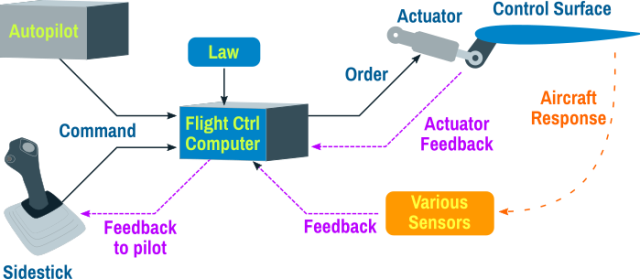Fly-by-wire (FBW) is a flight control system that replaces the mechanical linkages between the pilot’s control inputs and the aircraft’s control surfaces with electronic signals. In an FBW system, the pilot’s control inputs are detected by sensors and transmitted to a computer system, which then calculates the appropriate response and sends signals to actuators that move the control surfaces.
Pioneer in commercial aviation airplanes of Fly-By-Wire was Airbus, with the release of Airbus A300 back in 1972.
FBW systems offer a number of advantages over traditional mechanical flight control systems. They are lighter, simpler, and more reliable. They also allow for greater flexibility in the design of aircraft, as the flight controls can be programmed to compensate for aerodynamic instabilities and to provide the pilot with more precise and responsive control.

FBW systems were first used in military aircraft in the 1960s, and they have become increasingly common in commercial aircraft since the 1980s.
Today, most modern commercial airliners are equipped with FBW systems.
Advantages of fly-by-wire airplanes
FBW airplanes offer a number of advantages over traditional mechanical airplanes, including:
- Improved safety: FBW systems can help to prevent pilots from making control inputs that would put the aircraft outside its safe operating envelope. For example, an FBW system can prevent the pilot from stalling the aircraft or from overbanking in a turn.
- Increased performance: FBW systems can help to improve the performance of the aircraft by providing more precise and responsive control. This can lead to shorter takeoff and landing distances, improved fuel efficiency, and a smoother ride for passengers.
- Reduced weight and complexity: FBW systems are lighter and simpler than traditional mechanical flight control systems. This can lead to reduced manufacturing and maintenance costs.
- Increased flexibility in design: FBW systems allow for greater flexibility in the design of aircraft. For example, FBW systems can be used to design unstable aircraft that are capable of maneuvering at high speeds and altitudes.
How fly-by-wire airplanes work
An FBW system typically consists of the following components:
- Sensors: Sensors detect the pilot’s control inputs and the aircraft’s flight conditions. Common sensors include control position sensors, airspeed sensors, and gyroscopes.
- Computer system: The computer system receives the sensor signals and calculates the appropriate response. The computer system also contains the flight control laws, which determine how the aircraft will respond to the pilot’s control inputs.
- Actuators: Actuators move the control surfaces in response to the computer system’s signals. Common actuators include hydraulic actuators and electric actuators.
When the pilot moves the control stick or rudder pedals, the sensors detect this movement and send signals to the computer system. The computer system then calculates the appropriate response and sends signals to the actuators to move the control surfaces.
For example, if the pilot moves the control stick to the left, the computer system will send signals to the actuators to move the ailerons on the left wing down and the ailerons on the right wing up. This will cause the aircraft to roll to the left.
FBW systems are typically redundant, meaning that there are multiple computer systems and actuators.
This redundancy helps to ensure that the aircraft remains controllable even if one of the components fails.
Examples of fly-by-wire airplanes
Some examples of fly-by-wire airplanes include:
- Commercial airliners: Airbus A320 family, Boeing 777, Boeing 787
- Military aircraft: F-16 Fighting Falcon, F-35 Lightning II, F-22 Raptor
- General aviation aircraft: Cirrus SR22, Cessna Citation X, Embraer Phenom 300
Conclusion
Fly-By-Wire airplanes offer a number of advantages over traditional mechanical airplanes, including improved safety, increased performance, reduced weight and complexity, and increased flexibility in design. As a result, FBW systems are now used in all modern commercial airliners and in many military and general aviation aircraft.
Future of fly-by-wire airplanes
The future of fly-by-wire airplanes is bright. FBW technology is constantly evolving, and new and innovative applications are being developed all the time. For example, FBW systems are being used to develop autonomous aircraft that can fly without the need for a human pilot.
FBW systems are also being used to develop new types of aircraft, such as hypersonic aircraft that can fly at speeds of Mach 5 or higher. These aircraft could revolutionize transportation and make it possible to travel between continents in just a few hours.
Overall, FBW technology is a key enabler of the future of aviation. FBW airplanes are safer, more efficient, and more capable than traditional mechanical airplanes. As FBW technology continues to evolve, we can expect to see even more innovative and exciting applications in the years to come.


0 Comments